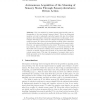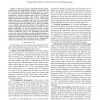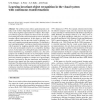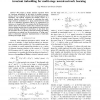55 search results - page 6 / 11 » Learning invariance through imitation |
BIOADIT
2004
Springer
14 years 23 days ago
2004
Springer
Abstract. How can artificial or natural agents autonomously gain understanding of its own internal (sensory) state? This is an important question not just for physically embodied ...
IJCNN
2006
IEEE
14 years 1 months ago
2006
IEEE
— In-place learning is a biologically inspired concept, meaning that the computational network is responsible for its own learning. With in-place learning, there is no need for a...
RA
2003
13 years 8 months ago
2003
Behavioural cloning is a method by which a machine learns control skills through observing what a human controller would do in a certain set of circumstances. More specifically, t...
BC
2006
13 years 7 months ago
2006
Abstract The cerebral cortex utilizes spatiotemporal continuity in the world to help build invariant representations. In vision, these might be representations of objects. The temp...
IJCNN
2006
IEEE
14 years 1 months ago
2006
IEEE
— We present a simple, intuitive argument based on “invariant imbedding” in the spirit of dynamic programming to derive a stagewise second-order backpropagation (BP) algorith...




